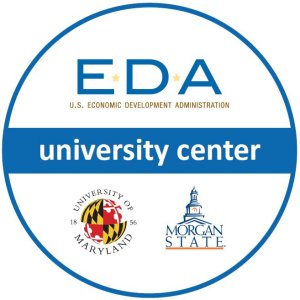 The economic and community development cluster explores methods of promoting high technology jobs and economic growth in our metropolitan areas, the redevelopment of distressed communities, and methods of promoting sustainable economic development. A grant from the U.S. Economic Development Agency designates the University of Maryland as an EDA University Center. The EDA center, which is joint with Morgan State, involves faculty and students in the redevelopment of the distressed community surrounding Morgan State and the best ways to create an innovative economy that fosters economic growth and high quality jobs. Students and faculty in this specialization come from the fields of urban planning, real estate, economics, sociology, and architecture.
The economic and community development cluster explores methods of promoting high technology jobs and economic growth in our metropolitan areas, the redevelopment of distressed communities, and methods of promoting sustainable economic development. A grant from the U.S. Economic Development Agency designates the University of Maryland as an EDA University Center. The EDA center, which is joint with Morgan State, involves faculty and students in the redevelopment of the distressed community surrounding Morgan State and the best ways to create an innovative economy that fosters economic growth and high quality jobs. Students and faculty in this specialization come from the fields of urban planning, real estate, economics, sociology, and architecture.
At Morgan University, scholars are working in the Morgan Community Mile Economic Development Project, a Northeast Baltimore neighborhood initiative to engage stakeholders in producing mutually defined community plans and projects, measurable outcomes, and positive community impact.
http://communitymile.morgan.edu/
Faculty:
Howell Baum
Professor Emeritus
Sidney Brower
Professor Emeritus
C. Scott Dempwolf
Director, UMD Morgan State Center for Economic Development
Chengri Ding
Professor
Marie Howland
Professor Emerita
Gerrit Knaap
Professor - Executive Director, National Center for Smart Growth Research and Education
Willow Lung-Amam
Associate Professor, Urban Studies & Planning
National Center for Smart Growth
-
Seed Initiative: The SEED Initiative's primary objective is to develop, promote, and implement an equitable and sustainable economic development approach in PlanMaryland, the State's first state-wide development plan.
-
STAR Project: Working with local governments, civic organizations, and local residents in Western Maryland to identify the particular needs and opportunities for sustainable economic development.
Suburban Redevelopment and Resistance: The Case for Equitable TOD
Planning Professor Willow Lung-Amam's project engages two important trends in the fields of planning and urban design—suburban “retrofit” or redevelopment and the suburbanization of poverty and immigration. Suburban retrofitting, which promotes more walkable, mixed-used, and compact suburban development, has recently become popular in many urban design and planning circles and has helped to transform many formerly sprawling suburbs into more prototypically “urban” places. At the same time, suburbia is undergoing massive demographic change. Once thought to be the sole province of white middle-class and elites, over the past few decades, suburbia has been at the center of America’s increasing social diversity—home to the majority of all racial and ethnic minorities, immigrants, and the poor.
This research focuses on the concerns raised by these two intersecting trends for disadvantaged communities. It asks how the resistance to suburban redevelopment and retrofit projects in low-income, minority, and immigrant communities informs the challenges of and to suburban redevelopment in an age of unprecedented suburban diversity and shifting geographies of metropolitan inequality. It probes questions about how communities are mobilizing to fight against such seemingly “good” urbanism, what they are fighting for and against, how these projects’ location in suburbia both complicates and informs the debates about them, and the impacts of contemporary processes of suburban spatial transformation on socially and economically vulnerable communities. The research uses a case study approach focused on several low-income minority and immigrant communities in Washington, DC metro area, which have recently or are proposed to undergo major redevelopment.
This project hopes to forward a critical conversation about the way that contemporary suburban redevelopment and renewal practices are taking shape among urban planning and design scholars, practitioners, and policy makers. The project adds a sustained focus on questions of social equity to a discourse that has hereto largely focused on urban form and environmental sustainability. It proposes to proffer both cautionary tales as well as potential policy responses and design practices to better respond to the concerns of increasingly diverse and vulnerable suburban populations.
Patterson Park, Baltimore
Emeritus Professor Sidney Brower has entered into an agreement with the Department of Recreation and Parks of the City of Baltimore to undertake a year-long survey of users in Patterson Park. Surveyors will approach people in the park at four seasons of the year to ask their ideas and opinions about the park: what it is like now and what it should be like in the future. The survey is part of the City’s process of updating the master plan for the park. It follows earlier surveys in the park conducted by the School in 1994 and 2007. The surveys was undertaken by second year planning student Yijing. He, with assistance from local community volunteers, were working under the supervision of Professor Emeritus Sidney Brower.
